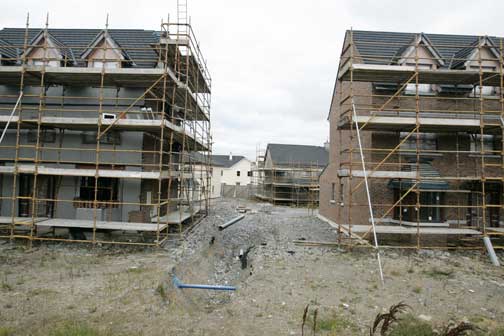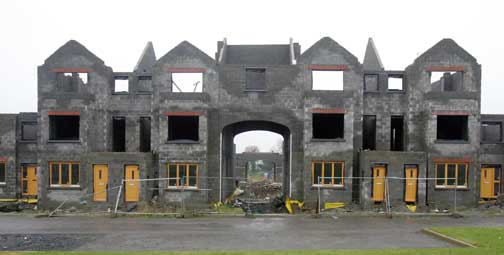


SERVICES
Tuesday October 26, 2010
Ghost Estates Haunt Ireland
What should have been a fine terrace of houses on the Rinuccini private housing development in Portlaoise, stands unfinished facing onto the main road and backs onto the occupied section of the estate (Photocall) Nothing captures the despair and destruction left behind by the bursting of Ireland's property bubble better than photos like these. And there are thousands upon thousands of others. A website has been created (www.ghostestates.com) which reveals the complete scale of the disaster. It's a Google-map of Ireland with red pins marking the locations of abandoned building sites. Click on the pin, and you will see a photograph of the estate or site concerned. The map of Ireland is covered with red pins - every province, every county, almost every town is represented. The website was the work of ordinary citizens, but this week an official State study was published which put exact numbers and locations on the problem. The Department of Environment study confirmed there are more than 2,800 ghost estates in Ireland. Building has started on 120,000 homes in these estates, but only 77,000 are complete and lived in. That means there are 33,000 empty, vacant, unsold or incomplete houses and apartments across the country. Ten thousand of these houses are in the early stages of construction and have been completely abandoned. In fact, builders are only continuing to work in one-in-six of the ghost estates. The report breaks down the figures, county-by-county. Worst affected are Carlow, Leitrim, Roscommon, Sligo and Longford. Cork has the most unsold homes with 3,427. But it's not just the empty or abandoned houses that are the problem - the real victims are those who bought houses or apartments in Phase 1 of the developments. In many cases, homeowners who live on estates where building work has ceased have also been abandoned and left without essential services. Sewers have been left open on the sites, water is contaminated and security lax. Thousands of homes are not served by roads, paths and public lighting - many of these essentials would be "finishing touches", undertaken by developers when the entire estate was completed.
The Battery Court luxury new housing development in Longford Town lays unfinished (Photocall) An expert group has now been set up to look at how to deal with the problem. It comprises, among others, local authorities, NAMA (the agency set up to take over non-performing loans from banks and pursue developers - it will end up owning many of these estates), representatives of the Construction Industry and health and safety authorities. The choices they face are stark. Experts say it could cost up to one billion euro to complete all the estates on which work has begun. There is simply no money to do this, nor is there a market for all the houses if completed. A portion of the houses will be taken over by NAMA, and completed and sold for as much as they can get. Others will be allocated to social housing - good news for those on waiting lists, but perhaps not what many of those who bought houses in these estates for inflated prices were expecting when they took out their massive mortgages. There has been talk of converting some ghost estates that are near completion into hospice or nursing home communities. But the awful truth is that hundreds if not thousands of these properties will simply bulldozed to the ground - symbols of the foolishness and recklessness that has brought Ireland to its knees. |
CURRENT ISSUE

RECENT ISSUES


SYNDICATE
[What is this?]
POWERED BY

HOSTED BY

Terms of Service | Privacy Policy
Website Design By C3I







